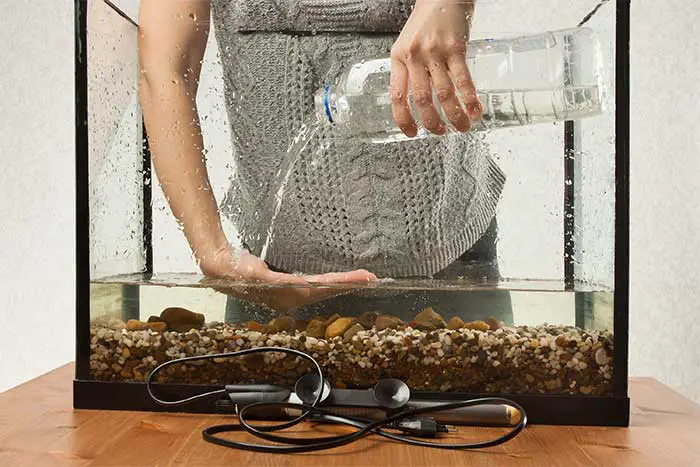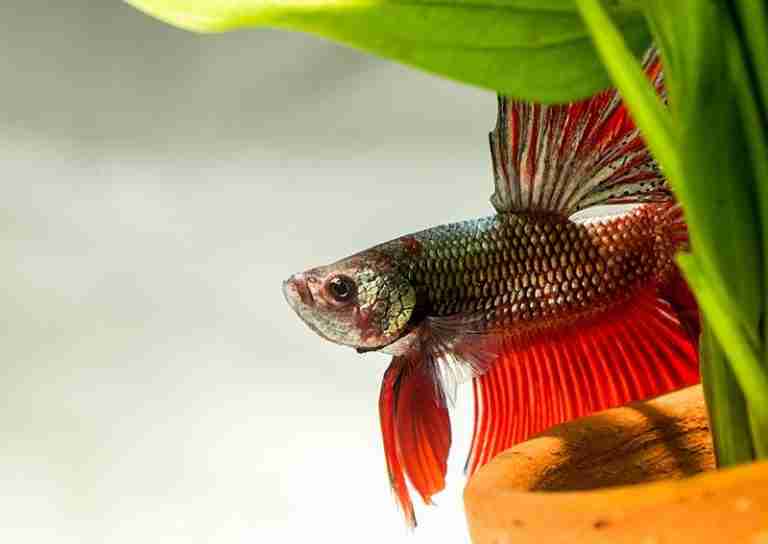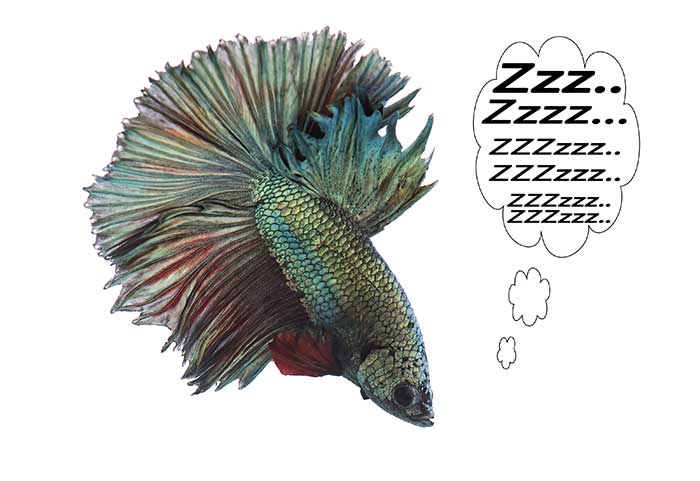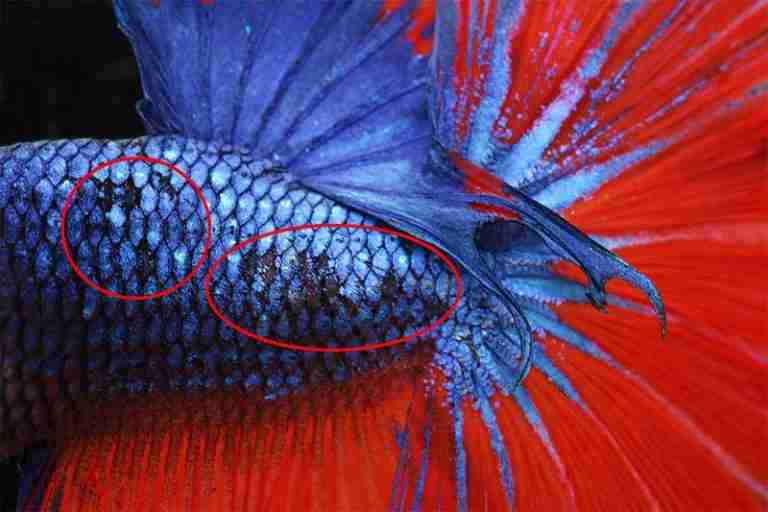Clown Loach Care Guide & Overview
Clown Loaches are wonderful freshwater fish that can greatly add to any freshwater aquarium. Good Clown Loach care will keep them in the best health and bring out their natural behavior, so they will be relaxed and get along well with many other fish.
The Clown Loach (Chromobotia macracanthus) or Tiger Botia is a freshwater fish with an elongated body and striped patterning. Their diet consists of plants, small crustaceans, worms, insects, and other invertebrates. Clowns should be kept in soft water with a neutral to slightly acidic pH.
Clown Loaches are easily identifiable by their bright orange to yellow color and 3 dark vertical bands along their body, one of which usually covers the eye. A Clown Loach has two lower fins and parts of the tail that are dark orange or red in color, and they have a black dorsal fin and odd-looking barbels around the mouth, which are sensory organs.
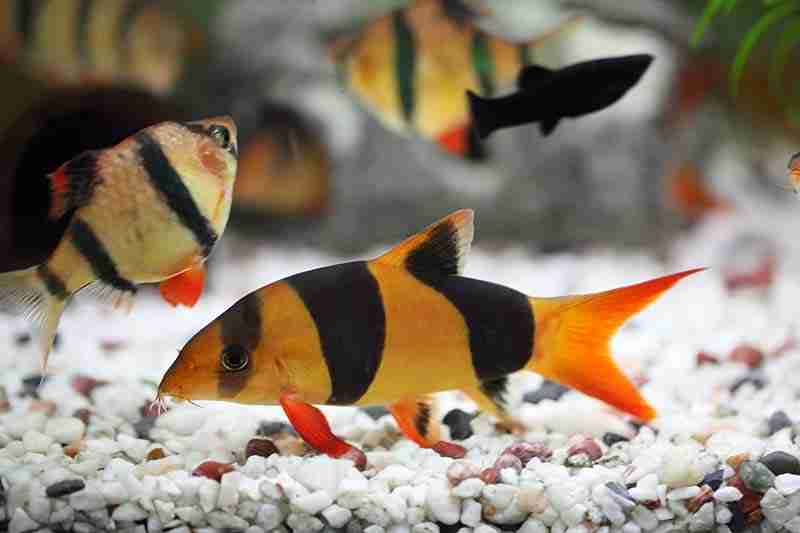
As non-aggressive fish, Clowns are often thought of as good community tank fish, with many potential tank mates they are compatible with.
Throughout this article, I will cover everything you need to know about Clown loach care, from how much space Clown Loaches need in a tank, their diet, temperament, compatibility with other fish species, breeding, health conditions, and much more.
By the end of this article, you should know everything you need to keep happy, healthy Clown Loaches that will live for many years.
Clown Loach Fish – Species Overview
| Scientific Name | Chromobotia macracanthus |
|---|---|
| Common Name | Clown Loach |
| Adult Size | 6-12 Inches In Captivity and Up to 16 Inches In The Wild |
| Average Lifespan | 8-10 Years In Captivity and up to 20-30 Years In The Wild |
| Minimum Tank Size Per Adult | 20-30 Gallons |
| Tank Dwelling Level | Bottom |
| Social Type | Peaceful |
| Solitary Or Schooling Fish | Schooling (Prefered groups of 5-15) |
| Diet | Omnivorous |
| Breeding | Spawners (Very difficult to breed in captivity) |
| Water Parameters | pH: 6-7.5 (Neutral to Slightly Acidic) Water Hardness: 100-200 ppm Temperature: 78°F (26°C) – 85°F (29°C) |
| Care Difficulty | Medium |
A Clown Loaches Natural Habitat
Mainly found in the central and western parts of South East Asia on the Indonesian islands of Sumatra and Borneo, you will usually find the Clown Loach fish amongst the rocky streams or rivers with moderate to low currents and a muddy substrate, where they like to lurk among the rocks and crevices.
The Clown Loach will prefer shady areas that are heavy in plants and other vegetation, providing them with plenty of food and places to hide from predators.
When many areas become temporarily flooded during the monsoon season, the Clown Loach will migrate upstream to spawn.
To the people of Sumatra and Borneo, Clown Loaches are considered food fish which is hard to imagine when you watch them in an aquarium setting.
Clown Loach Size
Don’t be fooled by the small size of these fish when they are young. These botiids can grow up to 16 inches or more in the wild, and although unlikely in captivity, you can still expect sizes of 6 to 12 inches in length. If you give these fish plenty of room to move around, feed them well, and care for them correctly, you will see the best growth from them.
You can learn more by reading an article I wrote on clown loaches size, which explains how big they can grow and the factors that influence their development, such as diet, tank size, and tank conditions.
Clown Loach Lifespan
A Clown Loach can live between 10 to 20 years in the wild, with some living for up to thirty. Many factors affect the lifespan of these fish in captivity, such as diet, health, and living conditions.
In captivity, you can expect to see these fish live for around 8-10 years.
An important aspect of Clown loach care is to know how long they are likely to live as it’s a long-term investment of your time, and when illness strikes, you will know if it’s due to old age.
Clown Loach Care Guide (Overview)
Now you have an understanding of the Clown loach species, let’s take a look at the specifics of good Clown loach care.
The rest of this article focuses on the most important areas to help you provide good care, including:
- Tank Setup (Size, substrate, water parameters, lighting, decoration, and plants)
- The Clown Loach Diet
- Tank Mates
- Clown Loach Behaviors
- Breeding
- Common Illnesses Found In Clown Loaches
My guide will help you will feel more confident in making the best choices before experience helps it become second nature. Your Clown loaches will certainly thrive in whatever tank setup you provide them with.
Clown Loach Tank Size and Setup
A home aquarium may not be a Clown Loaches natural environment, but it can be customized to become one.
The best tank setup for a Clown Loach is a tank with plenty of live plants and natural ornaments. As a freshwater fish, you will want to mimic their natural environment of rivers or lakes as much as possible.
These fish are omnivorous scavengers that like to find food on the bottom of tanks, so having sand or gravel at the base will be beneficial for them to forage.
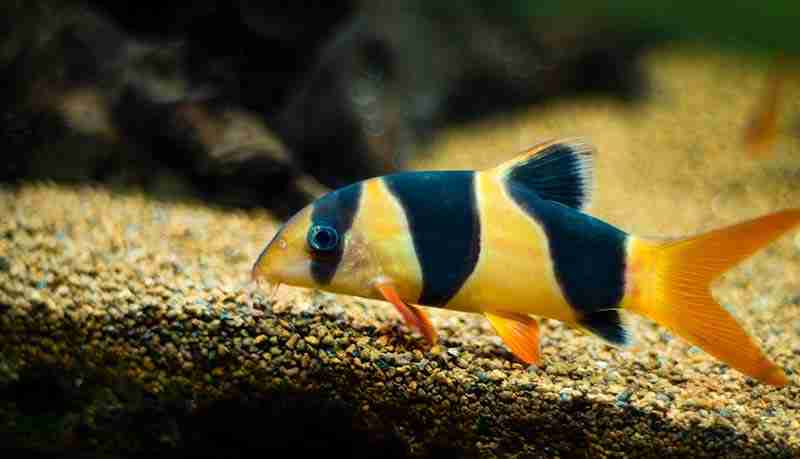
Clown Loaches are schooling fish that prefer to live in groups of at least 4 or 5, and even better, 10 to 15, so it is recommended that you get a tank that will be spacious enough to cope with their potential growth.
What Size Tank For A Clown Loach?
A single Clown loach will need a minimum tank size of at least 20-30 gallons, and a school of at least four to five Clowns will need a minimum tank size of 110-150 gallons. A good rule is allowing 30 gallons for each adult fish.
Tank size is important because although young Clowns are usually bought at around 1.5-2 inches, they can grow much bigger in captivity, and large Clown Loaches will need much bigger tanks.
Don’t worry if you intend to increase tank size later on, just make sure to follow the guidelines above to provide a spacious tank, especially if you want your Clown Loaches to feel happier so they will exhibit much more natural behavior.
Clown Loaches are usually non-aggressive fish, so they generally make good community fish. You may want to have them in or create a community tank with several other fish species.
Good tankmates are not too hard to find for the Clown Loach, but when doing so, it is important to provide a spacious tank for all fish and to avoid any fighting or aggressive behavior.
Community tanks often contain Clown Loaches and are often well-kept. In my experience, I have found many community tanks set up in businesses and office blocks that are just for show or added ambiance. Many are poorly stocked and neglected, with fish crammed together, often hiding out because they are stressed.
Poor conditions like these make larger fish become territorial over space and food, and providing good Clown loach care in a poorly kept environment would be almost impossible.
A Clown Loach tank needs plenty of room so it can swim freely and grow. This is especially important if you want to add other community fish. Mixing fish that live at different levels within the tank will be the best solution for space.
Preferred Substrate For Clown Loaches
The ideal substrate should be made of sand, gravel, or a mixture of the two in order for clown loaches to avoid skin irritations. These fish have rough boney plates on their body and cannot slough off dead scales unless they have a coarse substrate to rub against.
Gravel or rough sand is the perfect substrate, whereas soft, smooth pebbles will not help the clown loach exfoliate very easily.
Clown Loach Water Parameters And Conditions
Providing the best tank conditions is imperative for good Clown loach care, as poor water conditions can have an immediate or gradual, long-term effect on their health.
The best tank water conditions for a Clown Loach are clean and well-filtered water. As a member of the loach family, which includes catfish and carp; Clown loaches have many gill flaps that are sensitive to pollution or impurities in the water, so they need to breathe through their skin as much as possible.
Water parameters should be around pH from neutral to slightly acidic, water hardness around 100-200 ppm with a water temperature of 78°F (26°C) – 85°F (29°C). Water temperature as low as 75°F (24°C) can be tolerated but not advised over long periods.
Do not use untreated tap water as it can often have significant chemicals that could harm the Clown Loach. A good filter is recommended to remove any impurities or chemicals from the tank water.
If you are adding Clown Loaches to a new tank, it’s important to cycle the tank before adding them to avoid potential health problems. Water hardness and pH should be tested before adding the Clown Loaches to ensure they are compatible with their new home.
If you are new to water pH and other water parameters, you might benefit by reading the articles below:
How Do You Oxygenate A Fish Tank.
Tank Lighting
Clown Loaches prefer softer lighting to help them feel more at home, similar to where these fish live in their natural environment.
The best choice for lighting is a fluorescent tube on the blue/aqua spectrum because they are less likely to produce unsightly algae and can often be found with lower energy consumption than other lights. Some people also use full-spectrum bulbs under hoods to keep the water in the tank clear and sparkling, which will be better for plants photosynthesizing many wavelengths.
Keeping a well-planted tank will also help the Clown Loach because they prefer a dark and shaded environment to help them escape natural predators.
Decoration And Plants
Once you have the aquarium set up, adding natural ornaments and plants is best to make your Clown loaches feel as natural as possible.
A natural habitat for Clowns is a tank with plenty of live plants that have floating leaves, submerged ones, and natural ornaments like roots from trees or rocks to provide cover. You can also attach plants to driftwood and rocks if you want to make it look more natural but do not create an overgrown forest.
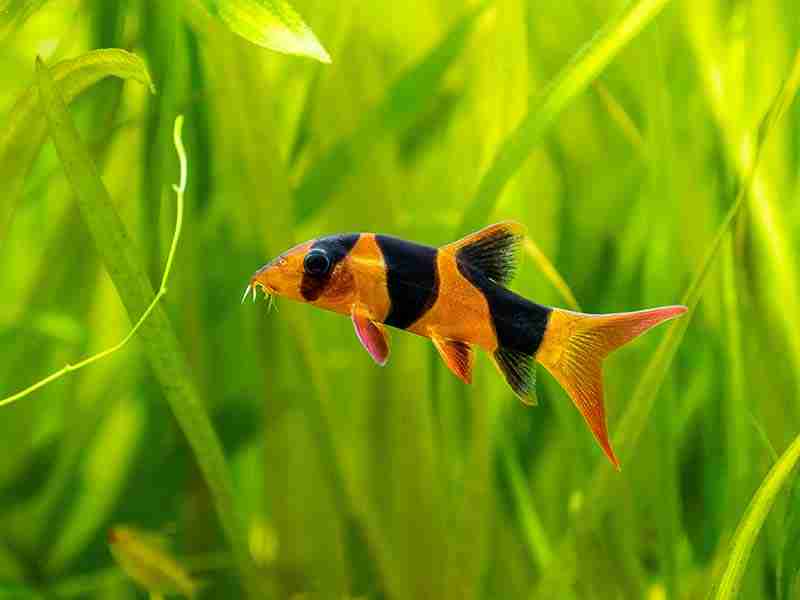
The best plants to have in the tank are natural ones such as Java Fern or Vallisneria which will withstand the natural grazing of this fish.
Floating plants like hornwort can provide a natural hiding place for fry and provide the Clown Loach with natural food.
Submerged plants like Java Moss, Water Wisteria, or Anubis will provide more natural cover for this fish while digging around on the bottom of tanks at night. They don’t usually eat submerged plants but sometimes use them as natural barriers.
A natural habitat for Clown Loaches is a must! It’s important to have plants that will be able to survive grazing and provide food as well as hiding places.
Ornaments are great for Clown Loaches as they like being able to explore natural-looking caves and tunnels.
They also like natural decorations such as plants that provide natural cover, cave/tunnel structures, or rock formations. They will even play with them by swimming behind it and hiding in the crevices between rocks!
Clown Loach Diet and Feeding
Clown Loaches are bottom-dwelling fish and eat natural food found on the bottom of tanks that they will scavenge for.
The Clown loach’s diet is primarily plant matter, but they’ll also enjoy fresh vegetables and fruit in moderation. As bottom-feeders, you must ensure that their food will sink to the bottom of an aquarium tank.
Diet is important for a Clown Loach, and I have written a guide where you can find much more in-depth information about what clown loaches eat, how often to feed them, and much more.
Below is a list of live food that a Clown Loach will eat:-
- Brine Shrimp, Baby Brine Shrimp, and other small crustaceans.
- Small Fish (Tiny Fry)
- Earth Worms, Tubifex Worms, Blood Worms.
- Snails (Yes, Clown Loaches eat snails, so they can help with snail control).
If you don’t want to feed live food, the Clown Loach will also enjoy a good quality commercial flake or pellet food like shrimp pellets and algae wafers. Make sure there’s always some left in the tank, even if they haven’t touched it.
With snail populations usually an issue among most aquarists, Clown Loaches will get their protein even if you don’t want to feed them live food.
Some natural plant-based food that Clown Loaches eat are:-
- Plants that provide natural cover (Java Fern, Vallisneria) or edible leaves (Anacharis).
- The Clown Loach will also enjoy fresh vegetables such as lettuce, peas, spinach, broccoli, and cucumber.
- They also like to eat fruit such as apple slices or grapes but only in moderation!
Feeding a Clown Loach is easy. They are predatory fish, so they will enjoy the live food they can hunt, and you will find natural evidence on the bottom of an aquarium tank. You should always provide fresh vegetables for them, and make sure not to overfeed them with fruit!

Most fish stores will sell their own mix of fresh or frozen foods, or you can make your own mix at home.
By making your own mix, you will soon become accustomed to what your Clown Loach prefers to eat, and it can become an inexpensive way to feed them.
Many aquarists will mix tinned tuna or crab meat with other foods, turn it into cubes and freeze it. Frozen foods mean that you can keep the food fresh, and it will sink easier before it thaws in the warm tank water.
Clown Loach Tank Mates
Clown Loaches love the company of other fish as they are generally very social fish. They enjoy living among larger groups of other Clown Loach and will also enjoy the company of other peaceful fish that share their placid nature.
Male Clown Loaches are territorial, so you should only have one male for every four females in a group; otherwise, they will fight over territory or breeding rights.
The best Clown Loach tank mates are often other bottom-dwelling fish like the Bumblebee Catfish, Pleco, and Corydoras.
Some other tank mates that a Clown Loach will get on with are:-
- African Cichlids (Usually Non-Aggressive Dwarf Cichlids)
- Tetras (Hemigrammus, Nematobrycon)
- Tiger Barbs
- Silver Dollar Fish
- Gouramis.
- Rainbow Shark
- Bristlenose Pleco
- Black Widow Tetra
- Bala Sharks
All the fish listed will be good for a community fish tank, and many others will mix well with Clowns.
Gourami fish are a popular choice for Clown Loach aquariums and make great tank mates because they share similar traits and characteristics with the Clown Loach. They both enjoy living in groups and are very peaceful.
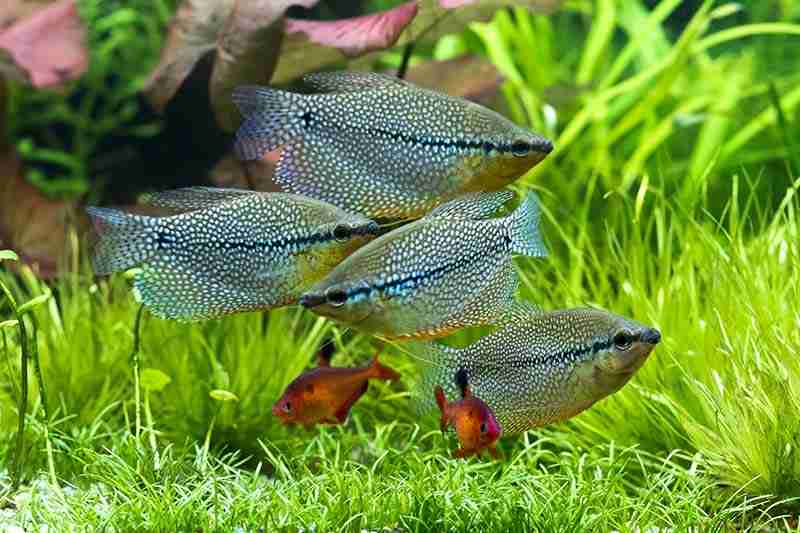
Adding some form of crustacean may be fun, and providing they are not so small to become a meal, they will definitely be suitable tank mates. A couple of suggestions would be a freshwater lobster or red-clawed crab.
There’s no guarantee that any two specific fish species will get on with each other, but those listed above have all been observed to have a positive relationship with Clown Loaches and should make good tank mates.
Clown Loach Behaviors
Clown Loaches exhibit a number of behaviors that make them interesting fish for any aquarium keeper with an eye for the unusual. They are fun fish to watch, and they will be more than happy to show you their little quirks if you can provide them with an environment that suits them best!
A few of the behaviors you may observe from your Clown Loach are:-
- Depending on the season, they may constantly dig up dirt and sand and bury themselves in the bottom of a tank to stay cool or warm.
- When they are stressed out, their dorsal fin can change color from red to black.
- Sometimes when sleeping, Clown Loaches go into something called a catatonic state. This is where they become inactive and unresponsive for periods of time, lasting anywhere from a few minutes to an hour or more, after which they return to normal behavior. When in a catatonic state, they lie at the bottom of the tank and appear dead.
- One really cool thing about the clown loach is that it can often change its color depending on its mood. Red is usually a sign of happiness, while black indicates stress.
- Clown Loaches have also been observed to change color when they are in mating mode! These fish are not unheard of to light up and glow with various colors.
- These fish are called “Clown” loaches for a reason. They are very friendly fish and will often nip at your fingers if you try to touch them in the tank, but beware as they have a small sharp barb called a suboccular spine which can be found retracted in their snout. Although not poisonous, it can poke the spine out and give you a nasty prick when the Clown Loach feels threatened.
Whether you are an experienced aquarist or not, few fishes are as rewarding to own as a Clown Loach. They are a fun and social fish to have in your tank and great fun to watch, so long as you remember their specific care requirements!
Breeding Clown Loach
Breeding Clown Loaches is better left to the experts because it is a difficult process, and reports of successfully breeding these fish in captivity are scarce, which is why most Clown Loaches are caught in the wild.
If you want to breed clown loaches, the adult fish must be a sexually mature pair. You need two or more pairs of clown loaches that are at least six inches (15 centimeters) long to have a good chance of successful breeding.
It takes about six months for an adult pair of Clown Loaches to reach sexual maturity, so leave them in peace if you want any chance to breed them. In fact, it could be worthwhile using a breeding tank during this time.
To have the best chance of successfully breeding Clown Loaches, the water temperature should be around 78°F (25°C). The male will clean the female’s body to remove any eggs, and then she will lay them on a flat surface.
The pair of Clown Loaches will create a bubble nest wherever they lay eggs, which is made up of air bubbles from the mouth or gills.
During breeding, the male has to go into a state of rest and can’t eat, so it’s important that he is well-fed before you try to breed them!
A healthy Clown Loach can have between 25-100 fry per brood, and they will be a variety of coloring as the genes are spread out in each generation.
If you want to breed Clown Loaches, then it’s best to keep them with a group of females in the same tank rather than just one so that there is always someone waiting for the male when he becomes sexually mature and ready to reproduce again.
Whether you keep these fish in the same tank whilst waiting for the eggs to hatch is up to you, but the females are known to eat their eggs, so it may be wise to keep them in separate tanks.
Common Illnesses Found In Clown Loaches
The Clown Loach is quite susceptible to certain illnesses. Knowing what to look for is good so you can find the right treatments quickly and before they become more serious and widespread throughout your tank.
Some common illnesses that clown loach can suffer from are:
- Ichthyophthirius multifiliis – Commonly known as “White Spot” or “Ich.”
- Fin Rot
- Stress
Ichthyophthirius multifiliis – Ich or White Spot
White spot is a parasite that causes fish to lose their color and become lethargic. A common way of treating it is with an antibiotic such as Kanamycin Sulfate or Tetracycline, but you also need to test the water levels for ammonia, nitrite, and nitrate, which can help this parasite to develop.
Ich can also be treated with a salt bath of one teaspoon (five grams) of aquarium salt per five gallons (19 liters) of water for three days in order to kill the parasite and remove it from the fish’s body.
Clown Loach Fin Rot
Fin rot is a bacterial infection, often made worse when your fish tank’s ammonia, nitrite, or nitrate levels are too high. You must regularly test these levels, especially when your clown loach has lost color in its fins. You should treat fin rot with antibiotics such as Tetracycline and maintain good water quality with regular partial changes.
Stress
These fish will show signs of stress in various ways, such as staying at one end of their tank or not eating, but if they’re showing these signs more often, it could also be because they have a bacterial infection, so you should give them antibiotics too.
Keeping an eye on water parameters and cleanliness in your fish tank will go a long way to keeping your fish healthy and happy while living in your aquarium.
Wrap Up
Clown loaches are a wonderful fish to have in your aquarium, in fact, they are one of my favorite fish. They come with many quirks and provide hours of entertainment for their owners.
If you want one, be sure that you know how big they can grow as well as the size of the tank they need before buying them because it’s not possible to return them after purchase if they don’t work out.
I hope this article has been helpful in understanding these fascinating fish, we have many other articles about them on this site if you want to learn more about their needs, and I have linked to many of these articles above.


